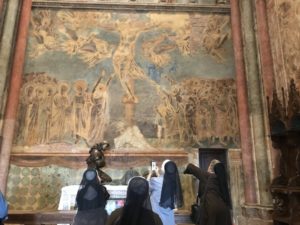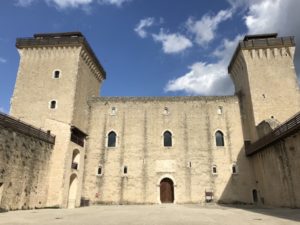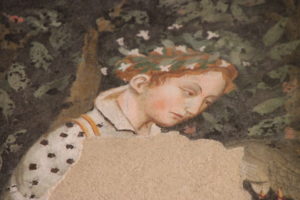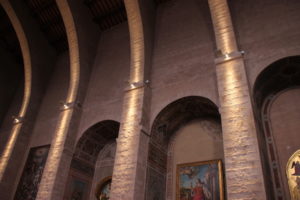In my 2018 holiday letter to friends, I described my funniest travel experience for the year as follows:
<<I visited Assisi in Italy and its Basilica of St. Francis. A sign at the basilica entry said, “no photos,” so tourists were sneaking shots like crazy. Near the altar, I watched a few nuns happily and openly shooting with smart phones, then standing around comparing their photos. I contained my glee long enough to photograph everything in the church, including them. Happily and openly.>>

Interior of Assisi’s Basilica of St. Francis. Above, frescoes surround the altar in the basilica’s lower level, photographed cautiously early in my visit. Below, frescoes and rose window seen in the long narrow nave of the basilica’s upper level, photographed later and with much greater confidence.
In fact, throughout a two-week trip, churches and other establishments often displayed the same signage, a camera with a slash through it. In one cathedral, we had a guide. She said it was OK to take photos as long as we did not use flash. With a new understanding of the signage, I took photos everywhere.
I visited these churches while traveling with three friends in October. I planned a busy travel schedule, confined mostly to Tuscany and Umbria, based on what the four of us agreed were either must-see or must-revisit destinations.
We rented a car to make this work — sort of.
Perugia is a city of around 165,000 and the capital of the Umbria region, but its historic center is an ancient hill town that retains much of its medieval character. Hence, we booked a hotel at the top of the hill, a few blocks from the cathedral.
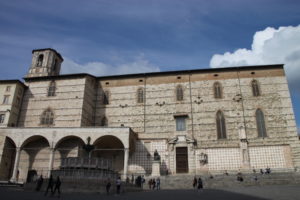
Perugia Cathedral in the center of Perugia’s historic district. We booked Hotel Fortuna to be near this and other tourist attractions.
But, getting there was torture. Once near or inside the city walls, we seemed to move in circles while the GPS tried to send us down streets that did not look car worthy. We called our hotel and were rescued.
After we unloaded bags at the front desk, the two drivers (not including me) took directions for a parking lot at the foot of the hill, then returned to the top of the hill via escalator.
On leaving town two days later, we hired a taxi to travel with bags from hotel to parking lot. That cost 10 euros total and bought us a lesson in how to drive in Perugia — assuming you know what you’re doing.
Our driver sped down steep narrow streets, driving roads we thought suited to wheelbarrows, neatly missing parked cars and taking sharp turns at speed. We laughed nervously in the taxi, and hysterically once in our rented car.
Actually, that was the funniest experience — it just took too many words to describe in a greeting card and you probably had to be there.
Ups and downs
Now, for more about escalators and other such uplifting mobility aids:
Part of the charm of a hill town is, of course, the hill — except maybe when you’re climbing it on a hot day.
Spoleto, site of the famed music festival, sits on the side of an impressive Umbrian hill called Sant’Elia and boasts a fortress at the top. Lung-squeezing climbs separate certain of the churches, museums and the cathedral from each other and, ultimately, from the fortress.
Some cities show subways and bus routes on their maps; Spoleto’s map shows the routes for escalators and elevators. Good thing, those escalators and elevators, because the views from the top shouldn’t be missed.
Inside the 14th century Albornoz Fortress, now a museum, we admired remains of medieval and late-medieval frescoes that must have once covered this place, then poked our cameras through grill windows for photos of Spoleto’s cathedral and the town’s rooftops below us plus green rolling hills/fields beyond.

Above and below frescoes in the Camera Pinta (Painted Room), inside the Albornoz Fortress. Frescoes in this room, created around the medieval concept of chivalry and the courtly life, were painted between 1392 and 1416. Below, a close-up.
This fortress, briefly home to Lucrezia Borgia, more recently (1817-1983) was a prison.
We used an elevator, followed by four escalators to get down to the cathedral, also still quite high up in this vertical town.

Views from Spoleto’s fortress. Above, a bucolic scene. Below, Spoleto rooftops, with the cathedral steeple seen in the left foreground.
Gubbio, the setting for eight seasons of the “Don Matteo” TV series, is not a hilltop site, but rather a place that crawls up the side of a steep mountain (Mount Ingino), though not to the top.
To see this small municipality, we needed to get from the town’s valley-level neighborhood to the levels of the Piazza Grande and on up to the level of the 12th century cathedral. (A still-higher basilica was accessible via cable car from the edge of town.)
Two elevators built inside the mountain, also shown on town maps, facilitated our sightseeing.
These modern projects are impressive, but Gubbio tackled the verticality of its terrain more dramatically in the 14th century by building the broad Piazza Grande where there was no such horizontal space available for a town square.
Medieval builders constructed huge vaults to support a square that literally hangs out over the mountainside. On the side open to the valley below, a wall, close to five feet tall, protects visitors from literally falling out of the square.
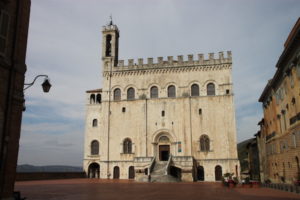
The Palazzo dei Consoli (Palace of the Consuls), anchoring the manmade Piazza Grande. The wall that keeps visitors from falling off the square is visible (sort of) at lower left.
Piazza Grande, the heart of town, was created to accommodate the Palazzo dei Consoli (Palace of the Consuls), a gorgeous white limestone building, now a museum but originally a government hall. We came by elevator to admire it, then boarded a different elevator to get up to one of the oddest churches in my photo files.
Gubbio’s 12th century cathedral has some nice fresco work around and above the altar, but the nave is a kind of vault wrapped with a series of floor-to-ceiling-to-floor arches that look like ribs. The ceiling has wooden beams. There are no pillars. The artwork in niches lining the nave is an eclectic collection.
Eventually, we walked down the mountainside, spotting and admiring the ceramics for which Gubbio is known, then found a delightful lunch site. I had a pasta with truffles, something else Gubbio is known for, meaning the truffles. Post-trip reading says Gubbio is renowned for its food. I thought all of Italy was.
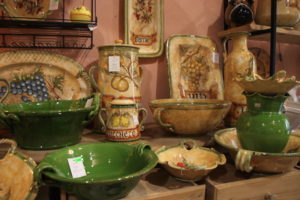
Ceramics seen in one of Gubbio’s several ceramic shops. I prefer to bring home this kind of souvenir (meaning breakable) in photos.
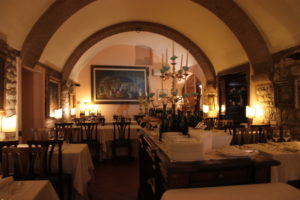
Above, Gubbio lunch site, the Taverna del Lupo, on a quiet afternoon. Below, my yummy pasta with truffles.
Quite by chance, this has turned into a narrative about Umbria only. Tuscany will be next.
For more about Italy, we offer at BestTripChoices.com the following, under the headline, The boot of Europe: https://besttripchoices.com/international-countries/italy/
This blog and its photos are by Nadine Godwin, BestTripChoices.com editorial director and contributor to the trade newspaper, Travel Weekly. She also is the author of “Travia: The Ultimate Book of Travel Trivia.”

